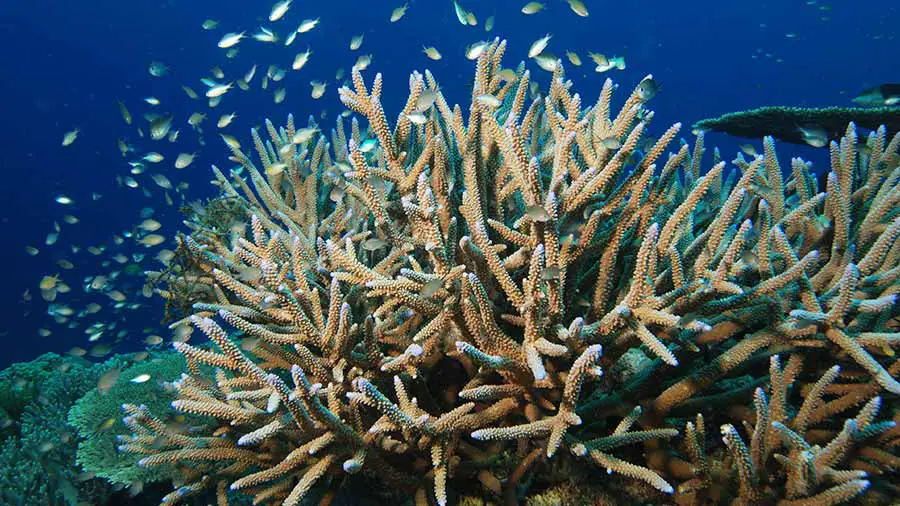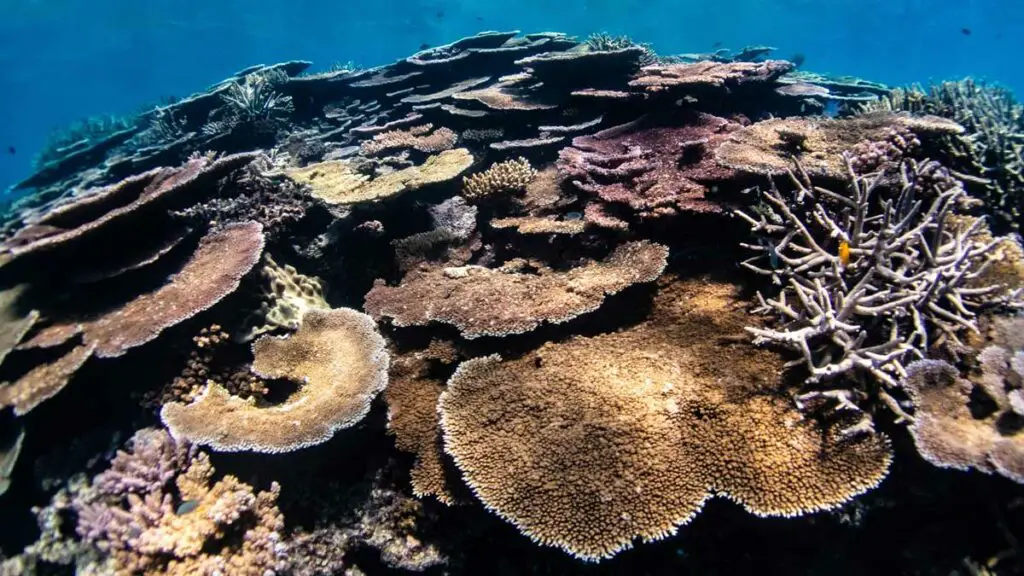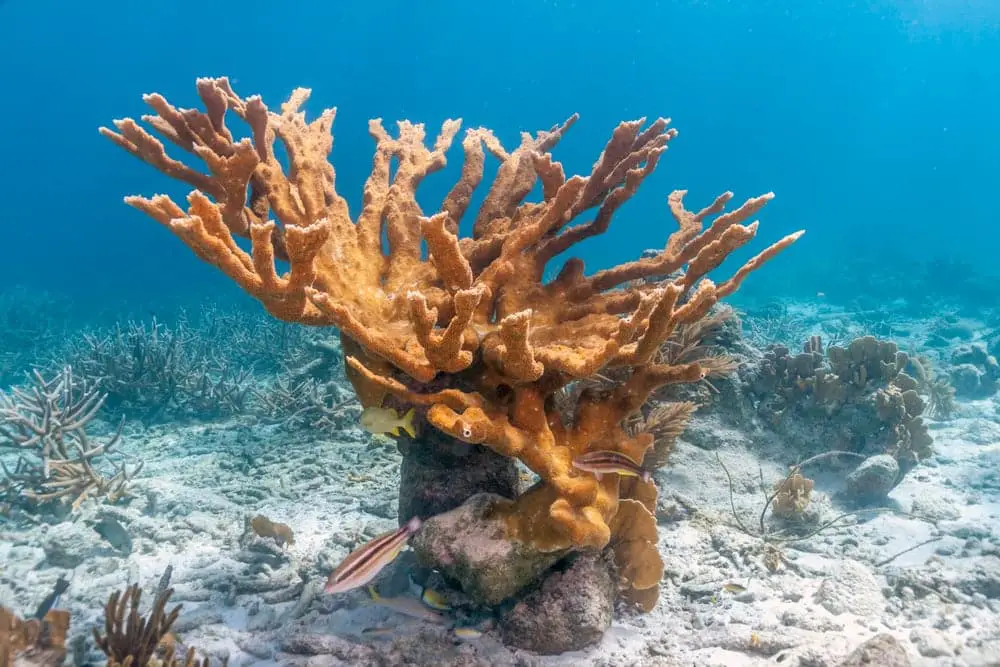How Many Types Of Coral Are There

Introduction
How Many Types Of Coral Are There: Coral reefs, often referred to as the “rainforests of the sea,” are among the most diverse and ecologically significant ecosystems on our planet. These vibrant underwater communities are home to a staggering variety of marine life, with coral formations serving as the cornerstone of this biodiversity. At the heart of coral reefs lie the corals themselves, fascinating organisms that come in a dazzling array of shapes, sizes, and colors.
Embarking on a journey through an enchanting underwater world where the boundaries between plant and animal seem to blur. Corals are not just captivating to the eye but are also vital for the health of our oceans. They provide habitat and sustenance for countless marine species, from tiny fish to majestic sea turtles.
In this exploration of coral diversity, we will delve into the intricate taxonomy of corals, uncovering the different families, genera, and species that make up this captivating group of organisms. From the branching elegance of Acropora to the massive boulders of Porites, each coral species has its unique characteristics and ecological role.

What are the 3 main types of coral?
The three main types of coral reefs are fringing, barrier, and atoll. Schools of colorful pennantfish, pyramid, and milletseed butterflyfish live on an atoll reef in the Northwestern Hawaiian Islands. The most common type of reef is the fringing reef.
Coral reefs, teeming with biodiversity, are primarily built by three main types of corals, each with its unique characteristics and ecological roles.
- Hard Corals (Scleractinia): Hard corals, also known as stony corals, are the primary reef builders. They secrete calcium carbonate skeletons that form the structural foundation of coral reefs. These corals exist in various forms, including branching, massive, and encrusting. Iconic examples include the branching Acropora and the massive brain corals (e.g., Favia). Hard corals often live in symbiosis with photosynthetic algae called zooxanthellae, which provide them with energy and vibrant colors.
- Soft Corals (Alcyonacea): Unlike hard corals, soft corals lack the stony skeletons and have a softer, more flexible appearance. They are adorned with a multitude of polyps that create a feathery or bushy appearance. Soft corals are known for their striking colors and unique growth forms. Popular examples include sea fans (e.g., Gorgonia) and sea whips (e.g., Leptogorgia).
- Black Corals (Antipatharia): Black corals are less well-known but equally intriguing. They derive their name from the black or dark brown color of their proteinaceous skeletons. Black corals are typically found in deeper, darker waters and feature a tree-like or whip-like structure. Some notable black coral species include Antipathes and Cirrhipathes.
These three main types of corals, along with a wide variety of species within each group, collectively contribute to the intricate beauty and functionality of coral reef ecosystems. They offer habitat, shelter, and sustenance to countless marine species while also serving as sentinels of environmental health, making their conservation of paramount importance in safeguarding the world’s oceans.
What are 5 importance of coral reefs?
Benefits of coral reef ecosystems
Coral reefs protect coastlines from storms and erosion, provide jobs for local communities, and offer opportunities for recreation. They are also are a source of food and new medicines. Over half a billion people depend on reefs for food, income, and protection.
Coral reefs are vital ecosystems found in the world’s oceans, and their importance cannot be overstated. Here are five key reasons why coral reefs are crucial to our planet:
- Biodiversity Hotspots: Coral reefs are often referred to as the “rainforests of the sea” due to their incredible biodiversity. They provide a habitat for countless species of marine life, including fish, mollusks, and sponges. Many species rely on coral reefs for food, shelter, and breeding grounds.
- Coastal Protection: Coral reefs act as natural barriers, protecting coastlines from erosion and storm surges. They absorb wave energy and reduce the impact of tropical storms, helping to safeguard coastal communities and infrastructure.
- Economic Value: Coral reefs support lucrative industries such as tourism and fisheries. They attract divers and snorkelers from around the world, contributing significantly to local economies. Coral reefs also provide a source of livelihood for millions of people who depend on fishing.
- Carbon Sequestration: Coral reefs play a role in mitigating climate change by sequestering carbon dioxide from the atmosphere. Although they cover less than 1% of the ocean floor, they capture and store large amounts of carbon.
- Medicinal Resources: Coral reefs are a potential source of novel pharmaceutical compounds. Many marine organisms living on reefs produce chemical compounds that have shown promise in the development of new medicines, including treatments for cancer and pain relief.
Preserving and protecting coral reefs is essential for the health of our oceans and the well-being of both marine and human communities. Conservation efforts are crucial to ensure the continued existence of these invaluable ecosystems.
How many corals are there?
Corals are anthozoans, the largest class of organisms within the phylum Cnidaria. Comprising over 6,000 known species, anthozoans also include sea fans, sea pansies and anemones.
The exact number of coral species on Earth remains a subject of ongoing research and discovery. There were approximately 2,500 to 3,000 known species of corals. Coral reefs are incredibly diverse ecosystems found in various marine environments, from shallow tropical waters to deep-sea habitats.
New species of corals are still being discovered, particularly in remote and less-explored regions of the ocean. Additionally, advances in genetic research and technology have enabled scientists to better understand and differentiate between coral species, potentially leading to the identification of previously unrecognized varieties.
The importance of knowing the exact number of coral species goes beyond mere curiosity. It has significant implications for conservation efforts, as many coral species are under threat from factors such as climate change, ocean acidification, and habitat destruction. Accurate species identification is crucial for designing effective conservation strategies to protect these vital components of marine ecosystems. Therefore, ongoing research and exploration are essential to comprehensively catalog the world’s coral diversity.
What is the most common coral?
The most common hard coral species are Boulder Star, Montastrea annularis, Great Star, Montastrea cavernosa, Massive Starlet, Siderastrea siderea, Mustard Hill, Porites astroides, and Grooved Brain, Colpophyllia natans.
The most common coral species in the world’s oceans are often found within the family known as “stony corals” or “hard corals.” Among these, the genus Acropora stands out as one of the most prevalent and diverse. Acropora corals are often referred to as “table corals” or “staghorn corals” due to their characteristic flat or branching growth forms, resembling tables or antlers underwater.
Acropora corals are widespread in tropical and subtropical marine environments, particularly in the Indo-Pacific region, including the Great Barrier Reef in Australia and various coral reefs throughout the Pacific and Indian Oceans. Their fast growth rates and ability to dominate reef spaces make them ecologically significant. They create complex structures that provide habitats for numerous marine species, which contributes to overall reef biodiversity.
However, it’s important to note that coral populations, including those of Acropora species, are under significant threat due to factors such as coral bleaching, ocean acidification, and coastal development. As a result, the abundance of these once-common corals is declining in many areas.
Efforts to protect and conserve these vital reef builders are crucial to maintaining the health and resilience of coral ecosystems worldwide, as well as preserving the rich biodiversity they support.
How many types of corals are there?
Six thousand species
There are about six thousand species of coral around the world, with some species growing in warm shallow waters near coastlines and others thriving on the dark, cold seafloor of the open ocean. Though coral may look like a colorful plant growing from roots in the seafloor, it is actually an animal.
Corals are incredibly diverse organisms, and they come in various shapes, sizes, and forms. There are approximately 800 to 1,200 known species of stony corals (Scleractinia), which are the primary builders of coral reefs. These stony corals can be further categorized into various genera and families based on their skeletal structures and genetic characteristics.
In addition to stony corals, there are soft corals (Alcyonacea), which belong to a different subclass of corals. Soft corals lack the hard calcium carbonate skeletons typical of stony corals and instead have flexible, fleshy structures. There are over 3,000 known species of soft corals, and they often exhibit vivid colors and intricate branching patterns.
Why is it important to identify different coral species?
Identifying different coral species is of paramount importance for several significant reasons:
Conservation and Biodiversity: Understanding the diversity of coral species is crucial for conserving coral reefs, which are among the most biodiverse ecosystems on the planet. Each coral species contributes to the overall biodiversity of the reef, providing unique habitats and niches for various marine organisms. Identifying these species helps scientists assess the health of coral ecosystems and develop targeted conservation strategies.
Resilience and Adaptation: Different coral species have varying levels of resilience to environmental stressors such as rising sea temperatures, ocean acidification, and pollution. By identifying resilient species, researchers can better understand which corals are more likely to survive in a changing climate. This knowledge can inform efforts to enhance the resilience of coral reefs through selective breeding or restoration projects.
Ecosystem Services: Coral reefs provide vital ecosystem services, including shoreline protection, fish habitat, and tourism revenue. Identifying the specific coral species within a reef helps quantify these services and their economic value, emphasizing the importance of reef preservation for both local communities and global society.
Scientific Understanding: Studying different coral species contributes to our understanding of coral biology, physiology, and ecology. This knowledge is invaluable for scientific research on coral reefs, climate change, and marine biology, helping us unravel complex interactions within these ecosystems.
Identifying different coral species is not merely an academic pursuit; it is fundamental for effective conservation, climate adaptation, and sustainable management of coral reefs. As these invaluable ecosystems face numerous threats, including climate change and habitat destruction, knowing and preserving the diversity of coral species is critical for the future health of our oceans and the countless species that rely on coral reefs for their survival.
How do scientists discover new coral species?
Discovering new coral species is an exciting and ongoing process that involves a combination of traditional taxonomy, advanced technology, and field research. Here’s how scientists go about finding and identifying new coral species:
- Underwater Surveys: Scientists conduct underwater surveys of coral reefs in various locations around the world. These surveys may involve scuba diving, remotely operated vehicles (ROVs), or submersibles. During these dives, researchers carefully examine the corals, looking for differences in morphology, color, and other physical characteristics that may indicate a new species.
- Molecular Techniques: Advances in genetic research have revolutionized coral taxonomy. Scientists often collect tissue samples from corals and analyze their DNA to determine their genetic distinctiveness. DNA barcoding and phylogenetic analyses help researchers identify new species and understand their evolutionary relationships.
- Microscopic Examination: Coral samples are often examined under microscopes to study the intricate details of their skeletal structures, polyp morphology, and other microscopic features that may be unique to a particular species.
- Comparative Analysis: Scientists compare their findings with existing literature, museum collections, and online databases to see if the newly discovered coral species match any known species or if they represent something entirely new.
- Taxonomic Validation: To formally establish a new species, scientists must follow taxonomic procedures and publish their findings in peer-reviewed scientific journals. This involves providing a detailed description of the new species, including its physical characteristics, habitat, and distribution.
- Collaboration: Coral taxonomy often involves collaboration among scientists from various institutions and disciplines. Expertise from marine biologists, geneticists, and taxonomists is combined to ensure accurate identification.
The process of discovering new coral species is ongoing, and it’s essential for understanding and conserving these vital marine organisms, especially as coral reefs face increasing threats from climate change and human activities.
Are all coral species found in coral reefs?
Coral reefs, often referred to as the “rainforests of the sea,” are vibrant and diverse ecosystems that host a remarkable array of marine life. However, it is a common misconception that all coral species are found exclusively within coral reefs. In reality, coral species are distributed across various marine environments, and not all of them are confined to reef ecosystems.
While coral reefs do harbor a substantial number of coral species, estimated at around 800 to 1,200, there are many other habitats where corals can thrive. Some corals can be found in deep-sea environments, such as cold-water coral reefs, while others inhabit coastal areas, seamounts, and even mangrove estuaries. These corals have adapted to a wide range of conditions and temperatures, allowing them to colonize different niches within the marine environment.
Understanding this broader distribution of coral species is essential for coral conservation efforts, as it highlights the need to protect not only coral reefs but also other habitats where corals play a crucial role. Studying coral species in diverse environments helps scientists unravel the secrets of their resilience and adaptability, offering valuable insights into how we can better safeguard these vital components of marine biodiversity.

Conclusion
The world of coral reefs is a mesmerizing tapestry of life, showcasing a remarkable diversity of coral species that continue to astonish and inspire scientists and nature enthusiasts alike. While it is challenging to pinpoint an exact number of coral species due to ongoing discoveries and taxonomic revisions, we have identified thousands of unique corals spread across various families and genera.
Our journey through the coral kingdom has revealed the extraordinary adaptability of these organisms, which have thrived in a range of environmental conditions, from the shallows of tropical seas to the dark depths of the ocean. We’ve witnessed the symbiotic relationships between corals and their microscopic algae, which are crucial for their survival and the vibrant colors of coral reefs.
Understanding the rich diversity of corals is not only an academic pursuit but a critical component of conserving these vital ecosystems. Coral reefs face numerous threats, including climate change, ocean acidification, and habitat destruction. As we strive to protect these delicate ecosystems, our knowledge of the various coral species becomes essential for targeted conservation efforts.
In our quest to unravel how many types of coral exist, we have deepened our appreciation for the intricate beauty and ecological importance of coral reefs. Preserving their diversity is not only an obligation but a privilege, ensuring that future generations can continue to marvel at the wonders of these underwater worlds and the myriad species that call them home.



